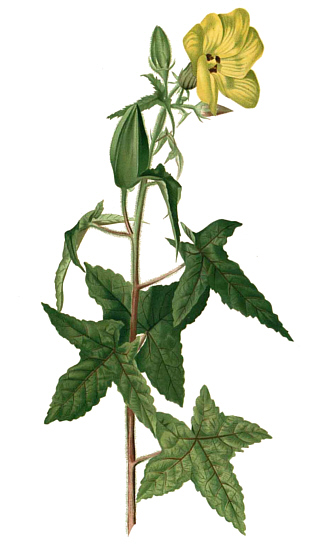

Zitierweise / cite as:
Carakasaṃhitā: Ausgewählte Texte aus der Carakasaṃhitā / übersetzt und erläutert von Alois Payer <1944 - >. -- Anhang A: Pflanzenbeschreibungen. -- Abelmoschus moschatus Medik. -- Fassung vom 2007-06-27. -- URL: http://www.payer.de/ayurveda/pflanzen/abelmoschus_moschatus.htm
Erstmals publiziert: 2007-06-27
Überarbeitungen:
Anlass: Lehrveranstaltung SS 2007
©opyright: Dieser Text steht der Allgemeinheit zur Verfügung. Eine Verwertung in Publikationen, die über übliche Zitate hinausgeht, bedarf der ausdrücklichen Genehmigung des Verfassers
Dieser Text ist Teil der Abteilung Sanskrit von Tüpfli's Global Village Library
WARNUNG: dies ist der Versuch einer
Übersetzung und Interpretation eines altindischen Textes. Es ist keine
medizinische Anleitung. Vor dem Gebrauch aller hier genannten Heilmittel wird
darum ausdrücklich gewarnt. Nur ein erfahrener, gut ausgebildeter ayurvedischer
Arzt kann Verschreibungen und Behandlungen machen!
Falls Sie die diakritischen Zeichen nicht dargestellt bekommen, installieren Sie eine Schrift mit Diakritika wie z.B. Tahoma.
Verwendete und zitierte Werke siehe: http://www.payer.de/ayurveda/caraka0001.htm
Verwendete und zitierte Werke siehe: http://www.payer.de/ayurveda/caraka0001.htm
Abelmoschus moschatus Medik. = Hibiscus abelmoschus L. = Hibiscus longifolius, Willd. = Abelmoschus rugosus Wight & Arn.
arab ḥabb al-misk = Moschuskörner; spätgriech. moschos = Bisam, Moschus
Malvaceae - Malvengewächse
"2-2,5 m hoch, mit langen, etwas steifen Haaren bekleidet, hat große gelbe, im Grunde dunkelrote Blumen. Der nierenförmige, 2-3 mm lange und 2 mm breite schwarzbraune Same mit erhabenen braunen Rippen bildet Abelmoschuskörner (Bisamkörner), welche beim Erwärmen moschusartig riechen und zu Riechpulvern, als Perlen, in Westindien auch gegen Schlangenbiss benutzt werden." (Wikipedia)
sanskrit:
kaṭuka: Caraka I,5.77 (āsyena dhāryāṇi)
Bhāvaprakāśa:
latā kasturī
dt. Ambramalve, Muskateller-Bisameibisch, Bisamstrauch
engl.: Musk, Musk Mallow
Inhaltsstoffe des Öls aus den Samen: Ambrettolid (Träger des Moschusgeruchs), Farnesol, Ambretolsäure, Palmitinsäure
Bhāvaprakāśa: I, S. 207
Pandey: II, 407ff.
Kirtikar-Basu: II, 454ff
Hunnius: s.v.
Wikipedia:
http://de.wikipedia.org/wiki/Abelmoschus. -- Zugriff am 2007-05-17
http://en.wikipedia.org/wiki/Abelmoschus_moschatus. -- Zugriff am
2007-05-17

Abb.: Abelmoschus moschatus Medik.
[Bildquelle: Wikipedia]
Drury:
"Abelmoschus moschatus (Moench). Do. Musk-mallow, Eng. Mushk-bhendi, Duk. Kasturi-Venday, Kathe-Kasturi, Tam. Kasturi-benda, Tel. Katta-Kasturi, Mal. Mushak-dana, Beng.
Description. — Stem herbaceous, hispid with spreading hairs, not prickly; leaves, and long petioles, hispid with rigid hairs, but otherwise glabrous, unequally and coarsely toothed, deeply 5-7 lobed; lobes all spreading, oblong or lanceolate; pedicels harshly pubescent, axillary, about as long as the petioles ; involucel-leaves 6-10, linear, hairy ; capsule oblong, acuminated, hairy; petals sulphur-coloured, dark crimson at the base. Fl. July—September.—W. & A. Prod. i. 53.— Hibiscus abelmoschus, Linn.—H. longifolius, Willd.—Rheede Mal. ii. t. 38.— Wight Icon. t. 399.-'—Bengal. Peninsula.
Medial Uses.—The highly-scented seeds are cordial and stomachic. When bruised, they have been given for the purpose of counteracting the effects of the bites of venomous reptiles, being applied both externally and internally. In the West Indies they are first reduced to powder, and then steeped in rum, and in this state are administered in snake-bites.
Economic Uses.—The plant abounds in mucilage, and is used in Upper India to clarify sugar. The seeds are used in Arabia for giving a perfume to coffee, and are also used in Europe as a substitute for animal musk in scenting powders and pomatums. The stem yields a strong fibre. Dr Roxburgh cut the stems while in flower, and immediately steeped them in water; these broke at an average weight of 107 lb., both when dry and wet. Among other fibre-yielding plants of this family may be mentioned the A. ficulneus (W. & A.), the bark of which contains a large proportion of very strong white fibre.—Boyle. Jury Rep. Mad. Exhib."
[Quelle: Drury, Heber <1819 - 1872>: The useful plants of India : with notices of their chief value in commerce, medicine, and the arts. -- 2d ed. with additions and corrections. London : Allen, 1873. -- xvi, 512 p. ; 22 cm. -- s.v.]